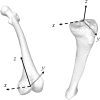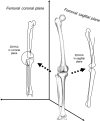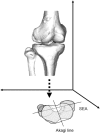Contribution of sex and body constitution to three-dimensional lower extremity alignment for healthy, elderly, non-obese humans in a Japanese population
- PMID: 30136191
- PMCID: PMC6104416
- DOI: 10.1186/s40634-018-0147-3
Contribution of sex and body constitution to three-dimensional lower extremity alignment for healthy, elderly, non-obese humans in a Japanese population
Abstract
Background: Humans support their bodies exclusively by vertical balance in bipedal locomotion, and the body, especially the lower extremity, generally changes with age. Sex and body constitution are assumed to be associated with lower extremity alignment, but this association remains to be elucidated. This study sought to clarify this association in healthy, elderly, non-obese humans in a Japanese population.
Methods: The present study investigated 55 healthy volunteers (mean age: 70 ± 6 years). A 3D extremity alignment system was applied under weight-bearing conditions on biplane long lower extremities X-rays using a 3D-to-2D image registration technique. The evaluation parameters included 3D hip-knee-ankle angle (3DHKA) alignment in the coronal (coronal alignment) and sagittal planes (sagittal alignment) and rotational alignment between the femur and tibia. The influences of sex and body constitution on all the alignment were analyzed.
Results: Multiple linear regression analysis with the dependent variable of each alignment showed that sex was the dominant factor for coronal and rotational alignment (coronal: p < 0.01; rotational: p < 0.01), and body weight was the dominant factor for sagittal alignment (p < 0.01).
Conclusions: The association of sex with coronal and rotational alignment and of body constitution with sagittal alignment were proved in healthy, elderly, non-obese humans in a Japanese population. This finding can lead to further understanding of the etiology of many diseases and age-related changes.
Keywords: Body constitution; Healthy elderly human; Lower extremity alignment; Sex.
Conflict of interest statement
Ethics approval and consent to participate
The study was approved by the Institutional Review Board in Niigata Medical Center. Appropriate consents, permissions and releases were obtained.
Consent for publication
All presentations had consent to publish.
Competing interests
The authors did not receive and will not receive any benefits or funding from any commercial party related directly or indirectly to the subject of this article.
Publisher’s Note
Springer Nature remains neutral with regard to jurisdictional claims in published maps and institutional affiliations.
Figures





Similar articles
-
Influence of posterior tibial slope on three-dimensional femorotibial alignment under weight-bearing conditions in healthy Japanese elderly people.Biomed Mater Eng. 2021;32(3):183-194. doi: 10.3233/BME-201209. Biomed Mater Eng. 2021. PMID: 33967036
-
Alignment in the transverse plane, but not sagittal or coronal plane, affects the risk of recurrent patella dislocation.Knee Surg Sports Traumatol Arthrosc. 2018 Oct;26(10):2891-2898. doi: 10.1007/s00167-017-4806-1. Epub 2017 Nov 17. Knee Surg Sports Traumatol Arthrosc. 2018. PMID: 29150745
-
Are advanced three-dimensional imaging studies always needed to measure the coronal knee alignment of the lower extremity?Int Orthop. 2017 May;41(5):917-924. doi: 10.1007/s00264-016-3340-y. Epub 2016 Nov 14. Int Orthop. 2017. PMID: 27844117
-
Native non-osteoarthritic knees have a highly variable coronal alignment: a systematic review.Knee Surg Sports Traumatol Arthrosc. 2019 May;27(5):1359-1367. doi: 10.1007/s00167-019-05417-2. Epub 2019 Mar 8. Knee Surg Sports Traumatol Arthrosc. 2019. PMID: 30848310
-
Highly variable coronal tibial and femoral alignment in osteoarthritic knees: a systematic review.Knee Surg Sports Traumatol Arthrosc. 2019 May;27(5):1368-1377. doi: 10.1007/s00167-019-05506-2. Epub 2019 Apr 15. Knee Surg Sports Traumatol Arthrosc. 2019. PMID: 30989273
Cited by
-
The coronal inclination of the medial tibial plateau affects coronal gait kinematics for varus osteoarthritic knees.Knee Surg Sports Traumatol Arthrosc. 2022 Dec;30(12):4162-4172. doi: 10.1007/s00167-022-07019-x. Epub 2022 Jun 3. Knee Surg Sports Traumatol Arthrosc. 2022. PMID: 35657392
-
Gravidity, parity and knee breadth at midlife: a population-based cohort study.Sci Rep. 2022 Jul 20;12(1):12415. doi: 10.1038/s41598-022-16231-1. Sci Rep. 2022. PMID: 35858984 Free PMC article.
-
The morphology of the femoral posterior condyle affects the external rotation of the femur.J Exp Orthop. 2023 Nov 25;10(1):122. doi: 10.1186/s40634-023-00686-w. J Exp Orthop. 2023. PMID: 38006419 Free PMC article.
-
Comparison of post-operative three-dimensional and two-dimensional evaluation of component position for total knee arthroplasty.Knee Surg Relat Res. 2021 Jul 13;33(1):21. doi: 10.1186/s43019-021-00106-2. Knee Surg Relat Res. 2021. PMID: 34256872 Free PMC article.
References
-
- Dubousset J. Three-dimensional analysis of the scoliotic deformity. In: Weinsteid SL, editor. The pediatric spine: principles and practice. New York: Raven Press; 1994.
-
- Ferrero E, Liabaud B, Challier V, Lafage R, Diebo BG, Vira S, Liu S, Vital JM, Ilharreborde B, Protopsaltis TS, Errico TJ, Schwab FJ, Lafage V. Role of pelvic translation and lower-extremity compensation to maintain gravity line position in spinal deformity. J Neurosurg Spine. 2016;24(3):436–446. doi: 10.3171/2015.5.SPINE14989. - DOI - PubMed
-
- Gervaise A, Teixeira P, Villani N, Lecocq S, Louis M, Blum A. Dose optimization and reduction if musculoskeletal CT including the spine. In: Tack D, Kalra MK, Gevenois PA, editors. Radiation dose from multidetector CT. 2. Heidelberg: Springer; 2012. pp. 369–388.
LinkOut - more resources
Full Text Sources
Other Literature Sources

